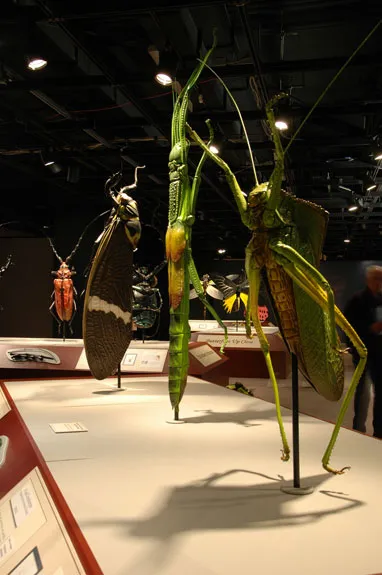Honey, I Blew Up the Bugs
Italian artist Lorenzo Possenti created 16 enormous sculptures of giant insects, all scientifically accurate, now on display at an Oklahoma museum
/https://tf-cmsv2-smithsonianmag-media.s3.amazonaws.com/filer/ab/d1/abd12619-bc9d-4bbc-bb75-b1d2d350afa0/stick-insect.jpg)
As a kid, I was an avid bug collector. I had one of those screen-covered bug boxes, and I carried it with me on backyard adventures and forays into the woods behind my house. I have fond memories of the first nights of summer when the fireflies came out–I’d cup the air and catch one, put it in my box and lie belly in the grass, with the box at my nose, watching the little thing light up.
My brother and I had ant farms, sea-monkeys and kits to grow monarch butterflies from caterpillars and frogs from tadpoles. Seeing little critters up-close was fascinating.
Now, about 20 years later, Lorenzo Possenti‘s sculptures reignite that passion in me. The Italian artist, based in Pisa, creates detailed sculptures of insects—from beetles and grasshoppers to dragonflies and butterflies—modeled after actual museum specimens. Possenti is remarkably accurate, according to entomologists, but he does take one liberty. His inanimate bugs are up to 200 times larger than life. Some of the beetles are four feet long, and the butterflies have five-feet wingspans!

“Like other children, I grew up thinking about monsters, extraterrestrials, dinosaurs…and huge bugs,” said Possenti, in an email. “When I was about 12 years old, I started to study insects and their biology, and I got a lot of books related to them. At the age of 15, I started drawing my own comics. Many dinosaurs, monsters and insects entered the stories.” Soon enough, insects took priority, and the artist transitioned from drawing to sculpture. “At the age of 25, I had the dream to produce my own exhibit about enlarged insect models, to show people how beautiful some of them (especially beetles) are,” he added.
Possenti builds his creatures piecemeal. Using museum specimens as reference, he sculpts each part of an insect from DAS modeling clay. Once the clay air dries, he uses sandpaper, knives and mini-drills to carve more details into the piece. This is his so-called “master copy.” The artist then covers the master copy with silicone rubber gum to form a mold. He removes the clay from the mold, pours a polyurethane resin into the mold and then, after the resin dries, extracts the resulting piece, be it a claw or an antennae, from the mold. Possenti cleans the part, joins it to other ones, paints the resulting critter and adds a special finish to the top, to give it a waxy-like surface similar to live insects.
“I can say that more than scientific issues, I am attracted by the art contained in insect body shapes, which comes from nature,” said Possenti. “That is why my models must be absolutely scientifically correct. The art shown in my models is not from me, it is from nature. My job is just to keep that safe, with as few changes as possible.”
The fact that Possenti has a degree in natural science, with a strong interest in entomology, helps as he strives for accuracy.
“He does a very good job at picking up on the details that usually an artist would miss,” said Katrina Menard, an entomologist and curator of recent invertebrates at the Sam Noble Oklahoma Museum of Natural History. The museum, located at the University of Oklahoma in Norman, is exhibiting 16 of the gargantuan insects in “Bugs…Outside the Box,” on display through May 12, 2013.
The herd of bugs includes a Hercules beetle (Dynastes hercules), a leaf grasshopper (Phyllophorina kotoshoensis), a stick insect (Megacrania tsudai), a jumbo dragonfly (Anotogaster sieboldii) and a giant cicada (Formotosena seebohmi), among others. But, Menard is particularly impressed by Possenti’s stag beetles.
“Along a lot of the different joints of these insects, they have large rows of hairs, called setae, so they are able to sense their position and movement,” explained Menard. “Usually, when you see pictures done by artists they sort of disregard these distinct little structures. In this case, he glued individual paintbrush hairs all along the joints that you would see only if you really looked at the insect very closely.”
The artist also pays special attention to the scales and venation of butterfly wings. He has created panels that allow museum visitors to feel the individual scales and how they lay across a wing. For the sake of the Sam Noble Museum exhibition, Possenti also made a dynamic sculpture of a beetle that allows teachers and students to remove certain parts of the bug—like in an autopsy, says the artist—to reveal its internal anatomy.
“He does a very good job translating not only the science but doing it in a very aesthetically pleasing and inclusive way,” Menard said. “People who normally wouldn’t be interested in looking at bugs up close actually want to look at the details and see the fine characteristics.”
Possenti’s mission is simple: “I would love for people to discover the art and the beauty of nature everywhere.”
/https://tf-cmsv2-smithsonianmag-media.s3.amazonaws.com/accounts/headshot/megan.png)
/https://tf-cmsv2-smithsonianmag-media.s3.amazonaws.com/accounts/headshot/megan.png)